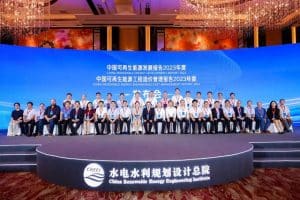In the 1980s and 1990s, China was a leading recipient of international aid but that is slowly beginning to change with China’s rapid development over the last 30 years. In the past decade, the Chinese government, at the central and provincial levels, and companies have begun providing more assistance to developing countries, mostly in the form of loans, trade deals, and investment. Up to now, Chinese GONGOs and NGOs have not played much of a role in China’s foreign aid program, but the case of CFPA shows that this is slowly starting to change.
The China Foundation for Poverty Alleviation is Ahead of Its Time
In 2004, the China Foundation for Poverty Alleviation (hereafter, CFPA, 中国扶贫基金会) began to shift its efforts to the entire world, proposing an “internationalization” development strategy. After careful deliberation, this strategy became the CFPA’s new direction.
Needs and Expectations on the Global Stage
What exactly does “internationalization” mean?
In the words of He Daofeng, the CFPA’s Deputy Director, it means that aid recipients, aid providers, and aid ideals and methods, be viewed from an international perspective, and that the CFPA’s poverty relief work be expanded overseas.
Mr. He believes that this strategy is closely related to facilitating China’s economic development and growing role in the global community, as well as the international community’s changing expectations regarding the role China will play as a major power.
Mr. He explains, when a country’s per capita annual income reaches 3000 USD, it generally marks what economists call the “Lewis Point” (the transition from labor excess to labor shortage). At this point, a country’s labor cost rises, and its demographic advantage declines, thereby forcing local companies to internationalize. In this transition, aid organizations should also internationalize their resources and methods.
Moreover, as [a country’s] economy develops, there is a large rise in donations from companies, which in turn leads to a demand from companies for internationalizing philanthropy. China’s transition from an aid-receiving country to an aid-providing country has brought about new expectations of China from the global community. “You cannot ignore the world’s suffering. You cannot turn a blind eye to African refugees. You cannot ignore the problems of the world!” Mr. He says with passion.
“With these kinds of expectations, we had to respond, otherwise China could not take its place as a major power.” Changes in the outside world led to corresponding changes in the CFPA. Our 20 years of experience allowed us to respond effectively to these new demands, Mr. He noted.
CFPA, however, was very cautious about implementing its internationalization strategy in the early stages, when it had no experience to draw from.
Mr. He recalls that when CFPA first began working in international aid, it always worked with international organizations in the hope of accumulating international experience. It was extremely cautious, concerned that any problems might result in bad press that would destroy its international work before it had really begun.
After 2005, CFPA began working with Mercy Corps and other international aid organizations, providing emergency supplies and medicines to help tsunami-affected areas in India, the US in the aftermath of Hurricane Katrina, and areas affected by the earthquake in Pakistan. In the aftermath of the Haiti earthquake, the CFPA raised RMB 2 million for the UN recovery effort in Haiti.
Criticism from the outside has also made it difficult for the CFPA to internationalize. People ask why is it that, even while China itself still has serious poverty, CFPA is so eager to cast its gaze to the world at large? In 2005, at the same time that CFPA was extending a helping hand to the Katrina disaster in the US, people called to complain, “What’s wrong with you? You’re ignoring problems at home. Even the government isn’t getting involved [with aid for Katrina]. What are you doing offering help?”
Mr. He explains, as a country develops, there are continual changes in the consciousness of the nation and its people. Different stages of development give rise to different opinions, which is to be expected. He even recommends that his employees record these complaints and criticisms and listen to them from time to time to observe the changes in China’s national identity and consciousness.
While CFPA itself has had repeated internal debates over the same issues, Mr. He recalls, “discussion, experimentation, and progress remain our core values, and we also maintain an atmosphere that is open, transparent, and conducive to learning.” Thus, in the end, everyone was able to reach an understanding.
At CFPA’s 2009 annual meeting, Mr. He even addressed the entire staff in a report on “how to meet the challenges posed by internationalization”.
“It’s a lot better now. We don’t get abusive phone calls anymore,” He Daofeng added.
Sudan as a Turning Point
Exploring its capabilities by providing early-stage emergency assistance to disaster-affected areas around the world allowed the Fund to gain some international experience. But Mr. He believes that it was not until October 2009, when CFPA completed its onsite survey in Sudan, that its “internationalization” really began. “CFPA went through five or six years of trial programs, but only now is it at a stage where we are ready to establish a real presence overseas.”
CFPA has used its work in Sudan as the starting point for further aid work in Africa. It plans to establish 13 hospitals for women and children to lower the maternal and infant mortality rates. At present, the first batch of supplies has already been shipped from China and CFPA is preparing for construction of its first hospital.
The maternal death rate in Sudan, Mr. He explained, is 1,300 deaths for every 100,000 births, far higher than China’s 30 deaths for every 100,000 births. Even in the poorest areas of Tibet, the maternal death rate is only about 100 for every 100,000 births. For pregnant women in Sudan, giving birth is literally like knocking on death’s door.
“In the past three years, there have been no maternal deaths in any of the 12 counties where CFPA has projects in China.” CFPA would like to take the lessons from the “120 actions for mother-child safety” project carried out in China and apply them in Sudan and other countries that lack medical resources and hygienic facilities, in its effort to lower maternal and infant mortality rates.
Of course, given that there is a difference between the medical resources available in China and Sudan, the methods that CFPA uses in China will differ somewhat from those used in Sudan. CFPA’s work in Sudan will include donations of equipment and skills ranging from constructing hospitals and training medical and management staff to sending volunteers to work directly with local medical staff. “This will be a symbolic example of the Fund’s internationalization strategy.”
Within the organization, CFPA has set up an International Development Department to promote its internationalization strategy. With Sudan as the starting point, CFPA hopes in the future to expand its activities to nearby Ethiopia, Chad, and Kenya, as well as other African countries.
Is CFPA Too Far Ahead of Its Time?
It seems that after the misunderstandings and doubts that plagued the early stages of its work, CFPA is slowly beginning to be understood and supported by others. The attitudes of both the government and companies are changing rapidly.
“Chinese companies have done a lot of charity overseas, but they do not sell it well. A lot of their money was not spent well. The money given to local governments was not very effective. Now the [Chinese] government wants to encourage some of its departments to give it a try,” explains Mr. He.
In speaking about the lessons learned from implementing its internationalization strategy, Mr. He seems to have internalized the lessons perfectly. First, Mr. He explained, the thinking has to change. Next, internationalization has to become the overall focus of the organization. Third, you need specialized departments to implement the strategy. Fourth, you need suitable staff. Fifth, you need to choose a location. Sixth, decisions have to be made about the kind of projects needed at that location. Who are the potential donors for the project? Who are you aiming to help? Then you need to select partners. Also, there need to be ways to monitor project implementation.
As to whether CFPA’s progress was “too far ahead of its time,” Mr. He did not have a direct answer. Compared to the emergency aid offered by other Chinese GONGOs, he said, CFPA has gone down a different path. GONGOs are stuck at the stage of simply allocating funds to disaster areas. He believes that CFPA should understand what the problems are in disaster-struck countries, and then design projects to deal directly with those problems. Otherwise, “how would it be any different from money from the government?”
“When Chinese companies go abroad, they need to be responsive to the needs of local communities. China’s role on the international stage is changing. We’re trying to meet new expectations, thinking about how to minimize the internationalization gap.”
As to whether or not [Chinese grassroots] NGOs would be able to develop internationally, Mr. He remarked, effective charity cannot just depend on someone’s passion. It’s something that requires skill and specialization. Nowadays, more and more young people are joining aid organizations, bringing with them new ideas about the world. The emergence of all sorts of new charities will add to this energy. But, he cautions, “Everything changes gradually, without any bells or whistles. It doesn’t just suddenly happen on one day. Only people with a steady heart, willing to think deeply, will be able to discover the course of this change.”



